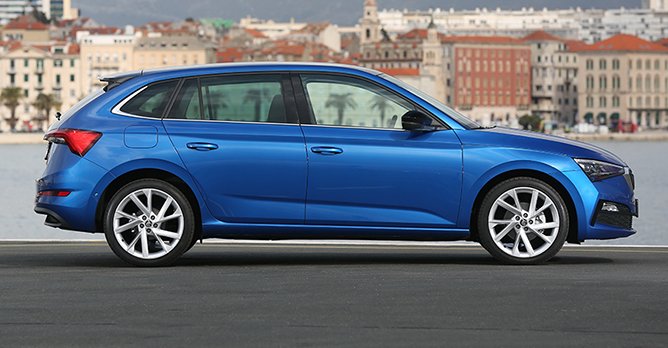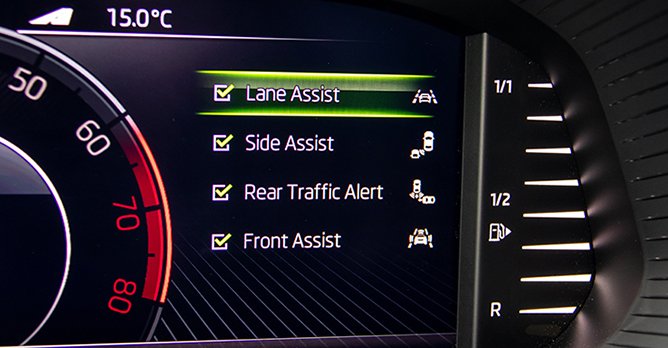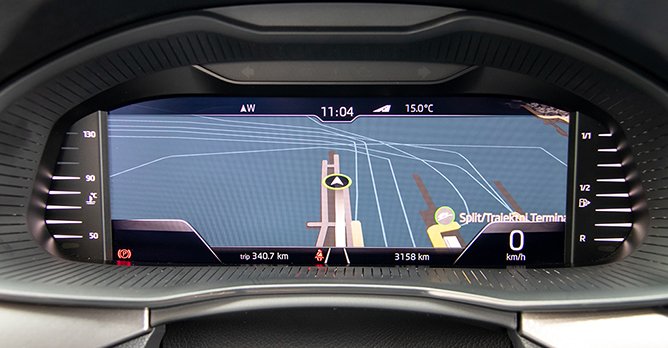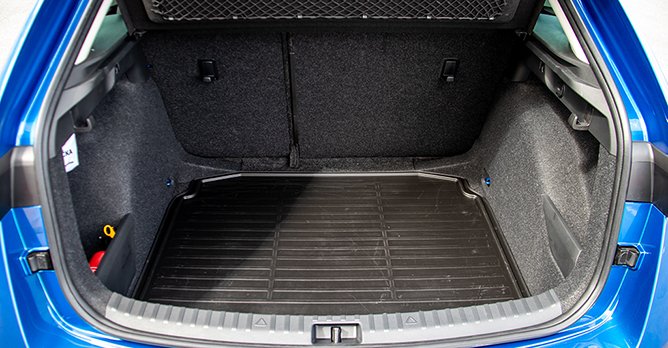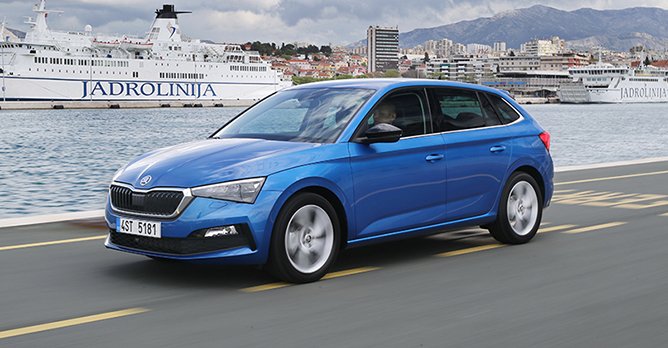Skoda Scala Style 1.0 (M) First Drive Review
22 Apr 2019|13,060 views
What We Like
Pleasant on the eyes
Ample space in the cabin
Large boot
High levels of equipment available
Perky 1.0-litre powerplant
What We Dislike
Automatic variant not yet available
Eventual pricing highly dependent on equipment specifications
We recently headed up to Split, Croatia, to test out the Skoda Scala, a brand new hatchback from the Czech manufacturer. At global market launch, a total of three engine variants are available - a 1.0-litre TSI engine, a 1.5-litre TSI engine, and well as a 1.6-litre TDI engine.
Look's pretty much the same to me…
Yes, the cars look remarkably similar, and that's quite simply because they are. The Scala is offered in a range of specifications (both engine and equipment), thus the car you see here looks pretty much the same as the 1.5-litre variant we drove.
But it's a manual?
The big difference is the car's transmission. At market launch, the 1.0-litre variant is offered with a six-speed manual gearbox. A seven-speed DSG variant will be produced later on in the year.
So why bother even testing this variant, you may ask? Well, it's because we suspect that when the car eventually makes its way to Singapore, it will likely be specced with the 1.0-litre engine that's mated to a seven-speed DSG gearbox.
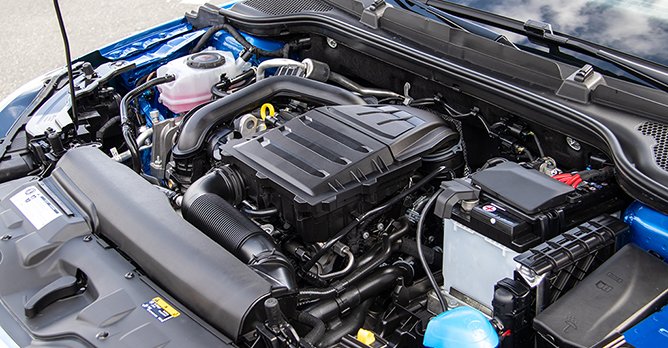
 The turobocharged 1.0-litre engine pumps out 113bhp and 200Nm of torque, and is well capable across most driving situations
The turobocharged 1.0-litre engine pumps out 113bhp and 200Nm of torque, and is well capable across most driving situations
The 1.5-litre engine was debuted in the Golf, but we suspect it hasn't been introduced in Singapore because it would push the car into the Cat B COE category. Thus, we don't expect Skoda to equip the Scala with the 1.5-litre engine for the same reason. Additionally, the 1.0-litre variant stands to be cheaper, hence making the Scala an even more attractive option price-wise.
So, we figured we should at least get behind the wheel of the 1.0-litre variant to get a feel of how the car is like.
So how does it feel, then?
In one word, familiar. After all, it's the same engine found in the Seat Ibiza, the Skoda Octavia and the Volkswagen Polo. It's a turbocharged three-cylinder engine producing 113bhp and 200Nm of torque. It's not going to help you break any land speed records, but for all intents and purposes it's a highly functional and useable engine.
Yes, you need to be a little heavier with the right foot when moving off from a standstill, but once you get going there's more than sufficient torque across most driving situations.
Look's pretty much the same to me…
Yes, the cars look remarkably similar, and that's quite simply because they are. The Scala is offered in a range of specifications (both engine and equipment), thus the car you see here looks pretty much the same as the 1.5-litre variant we drove.
But it's a manual?
The big difference is the car's transmission. At market launch, the 1.0-litre variant is offered with a six-speed manual gearbox. A seven-speed DSG variant will be produced later on in the year.
So why bother even testing this variant, you may ask? Well, it's because we suspect that when the car eventually makes its way to Singapore, it will likely be specced with the 1.0-litre engine that's mated to a seven-speed DSG gearbox.

The 1.5-litre engine was debuted in the Golf, but we suspect it hasn't been introduced in Singapore because it would push the car into the Cat B COE category. Thus, we don't expect Skoda to equip the Scala with the 1.5-litre engine for the same reason. Additionally, the 1.0-litre variant stands to be cheaper, hence making the Scala an even more attractive option price-wise.
So, we figured we should at least get behind the wheel of the 1.0-litre variant to get a feel of how the car is like.
So how does it feel, then?
In one word, familiar. After all, it's the same engine found in the Seat Ibiza, the Skoda Octavia and the Volkswagen Polo. It's a turbocharged three-cylinder engine producing 113bhp and 200Nm of torque. It's not going to help you break any land speed records, but for all intents and purposes it's a highly functional and useable engine.
Yes, you need to be a little heavier with the right foot when moving off from a standstill, but once you get going there's more than sufficient torque across most driving situations.
In fact, on some of the windy mountain roads in Croatia, it was quite fun to be able to wring out the engine and push it high into the rev counter. Rowing through the pleasantly smooth six-speed manual box also proved rather satisfying.
Even on highways, the Scala is capable of cruising along at 120km/h without feeling overly light and nervous. Push it hard, and it may even cross 170km/h (but we're not saying we did).
And the rest of the car?
The rest of the Scala is a fairly comprehensive package designed to deliver ample practicality, comfort and utility for a typical family. The cabin is spacious, the boot massive for its class, and fully kitted out the Scala is a thoroughly modern car that anyone can live with.
So we wait…
At this moment, it's still unclear when the Scala will be launched in Singapore because the company is still in talks with the factory regarding the specifications for the local model as far as engine and equipment are concerned.
That said, we expect the Singapore-specced Scala to be offered with a 1.0-litre engine, the seven-speed DSG gearbox as well as a range of equipment options.
Will Singapore get the full suite of features and technological equipment? It's hard to say. Ultimately, it will come down to the brand figuring out how best to equip the Scala such that it can be offered at an attractive pricepoint, probably in the region of $90,000 (COE price changes notwithstanding).
But with the attractive combination of ample practicality, easy accessibility and daily usability, it wouldn't come as a surprise that the Scala will be an inviting new hatchback choice for Singapore buyers.
Even on highways, the Scala is capable of cruising along at 120km/h without feeling overly light and nervous. Push it hard, and it may even cross 170km/h (but we're not saying we did).
And the rest of the car?
The rest of the Scala is a fairly comprehensive package designed to deliver ample practicality, comfort and utility for a typical family. The cabin is spacious, the boot massive for its class, and fully kitted out the Scala is a thoroughly modern car that anyone can live with.
So we wait…
At this moment, it's still unclear when the Scala will be launched in Singapore because the company is still in talks with the factory regarding the specifications for the local model as far as engine and equipment are concerned.
That said, we expect the Singapore-specced Scala to be offered with a 1.0-litre engine, the seven-speed DSG gearbox as well as a range of equipment options.
Will Singapore get the full suite of features and technological equipment? It's hard to say. Ultimately, it will come down to the brand figuring out how best to equip the Scala such that it can be offered at an attractive pricepoint, probably in the region of $90,000 (COE price changes notwithstanding).
But with the attractive combination of ample practicality, easy accessibility and daily usability, it wouldn't come as a surprise that the Scala will be an inviting new hatchback choice for Singapore buyers.
What We Like
Pleasant on the eyes
Ample space in the cabin
Large boot
High levels of equipment available
Perky 1.0-litre powerplant
What We Dislike
Automatic variant not yet available
Eventual pricing highly dependent on equipment specifications
We recently headed up to Split, Croatia, to test out the Skoda Scala, a brand new hatchback from the Czech manufacturer. At global market launch, a total of three engine variants are available - a 1.0-litre TSI engine, a 1.5-litre TSI engine, and well as a 1.6-litre TDI engine.
Look's pretty much the same to me…
Yes, the cars look remarkably similar, and that's quite simply because they are. The Scala is offered in a range of specifications (both engine and equipment), thus the car you see here looks pretty much the same as the 1.5-litre variant we drove.
But it's a manual?
The big difference is the car's transmission. At market launch, the 1.0-litre variant is offered with a six-speed manual gearbox. A seven-speed DSG variant will be produced later on in the year.
So why bother even testing this variant, you may ask? Well, it's because we suspect that when the car eventually makes its way to Singapore, it will likely be specced with the 1.0-litre engine that's mated to a seven-speed DSG gearbox.

 The turobocharged 1.0-litre engine pumps out 113bhp and 200Nm of torque, and is well capable across most driving situationsThe 1.5-litre engine was debuted in the Golf, but we suspect it hasn't been introduced in Singapore because it would push the car into the Cat B COE category. Thus, we don't expect Skoda to equip the Scala with the 1.5-litre engine for the same reason. Additionally, the 1.0-litre variant stands to be cheaper, hence making the Scala an even more attractive option price-wise.
The turobocharged 1.0-litre engine pumps out 113bhp and 200Nm of torque, and is well capable across most driving situationsThe 1.5-litre engine was debuted in the Golf, but we suspect it hasn't been introduced in Singapore because it would push the car into the Cat B COE category. Thus, we don't expect Skoda to equip the Scala with the 1.5-litre engine for the same reason. Additionally, the 1.0-litre variant stands to be cheaper, hence making the Scala an even more attractive option price-wise.
So, we figured we should at least get behind the wheel of the 1.0-litre variant to get a feel of how the car is like.
So how does it feel, then?
In one word, familiar. After all, it's the same engine found in the Seat Ibiza, the Skoda Octavia and the Volkswagen Polo. It's a turbocharged three-cylinder engine producing 113bhp and 200Nm of torque. It's not going to help you break any land speed records, but for all intents and purposes it's a highly functional and useable engine.
Yes, you need to be a little heavier with the right foot when moving off from a standstill, but once you get going there's more than sufficient torque across most driving situations.
Look's pretty much the same to me…
Yes, the cars look remarkably similar, and that's quite simply because they are. The Scala is offered in a range of specifications (both engine and equipment), thus the car you see here looks pretty much the same as the 1.5-litre variant we drove.
But it's a manual?
The big difference is the car's transmission. At market launch, the 1.0-litre variant is offered with a six-speed manual gearbox. A seven-speed DSG variant will be produced later on in the year.
So why bother even testing this variant, you may ask? Well, it's because we suspect that when the car eventually makes its way to Singapore, it will likely be specced with the 1.0-litre engine that's mated to a seven-speed DSG gearbox.

So, we figured we should at least get behind the wheel of the 1.0-litre variant to get a feel of how the car is like.
So how does it feel, then?
In one word, familiar. After all, it's the same engine found in the Seat Ibiza, the Skoda Octavia and the Volkswagen Polo. It's a turbocharged three-cylinder engine producing 113bhp and 200Nm of torque. It's not going to help you break any land speed records, but for all intents and purposes it's a highly functional and useable engine.
Yes, you need to be a little heavier with the right foot when moving off from a standstill, but once you get going there's more than sufficient torque across most driving situations.
In fact, on some of the windy mountain roads in Croatia, it was quite fun to be able to wring out the engine and push it high into the rev counter. Rowing through the pleasantly smooth six-speed manual box also proved rather satisfying.
Even on highways, the Scala is capable of cruising along at 120km/h without feeling overly light and nervous. Push it hard, and it may even cross 170km/h (but we're not saying we did).
And the rest of the car?
The rest of the Scala is a fairly comprehensive package designed to deliver ample practicality, comfort and utility for a typical family. The cabin is spacious, the boot massive for its class, and fully kitted out the Scala is a thoroughly modern car that anyone can live with.
So we wait…
At this moment, it's still unclear when the Scala will be launched in Singapore because the company is still in talks with the factory regarding the specifications for the local model as far as engine and equipment are concerned.
That said, we expect the Singapore-specced Scala to be offered with a 1.0-litre engine, the seven-speed DSG gearbox as well as a range of equipment options.
Will Singapore get the full suite of features and technological equipment? It's hard to say. Ultimately, it will come down to the brand figuring out how best to equip the Scala such that it can be offered at an attractive pricepoint, probably in the region of $90,000 (COE price changes notwithstanding).
But with the attractive combination of ample practicality, easy accessibility and daily usability, it wouldn't come as a surprise that the Scala will be an inviting new hatchback choice for Singapore buyers.
Even on highways, the Scala is capable of cruising along at 120km/h without feeling overly light and nervous. Push it hard, and it may even cross 170km/h (but we're not saying we did).
And the rest of the car?
The rest of the Scala is a fairly comprehensive package designed to deliver ample practicality, comfort and utility for a typical family. The cabin is spacious, the boot massive for its class, and fully kitted out the Scala is a thoroughly modern car that anyone can live with.
So we wait…
At this moment, it's still unclear when the Scala will be launched in Singapore because the company is still in talks with the factory regarding the specifications for the local model as far as engine and equipment are concerned.
That said, we expect the Singapore-specced Scala to be offered with a 1.0-litre engine, the seven-speed DSG gearbox as well as a range of equipment options.
Will Singapore get the full suite of features and technological equipment? It's hard to say. Ultimately, it will come down to the brand figuring out how best to equip the Scala such that it can be offered at an attractive pricepoint, probably in the region of $90,000 (COE price changes notwithstanding).
But with the attractive combination of ample practicality, easy accessibility and daily usability, it wouldn't come as a surprise that the Scala will be an inviting new hatchback choice for Singapore buyers.
Thank You For Your Subscription.





























